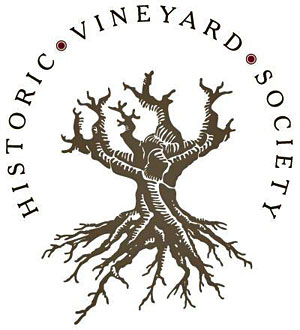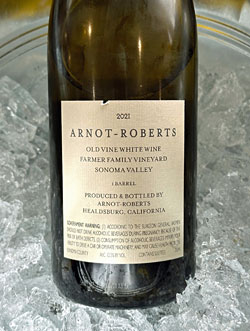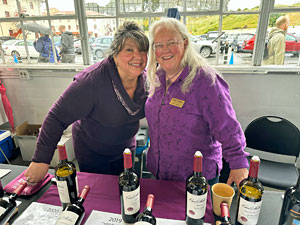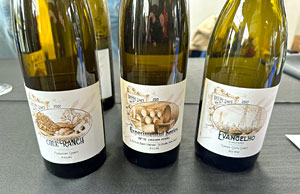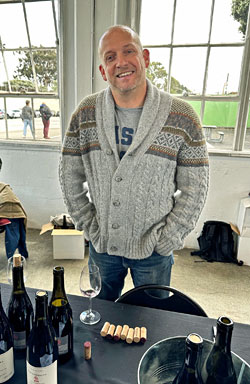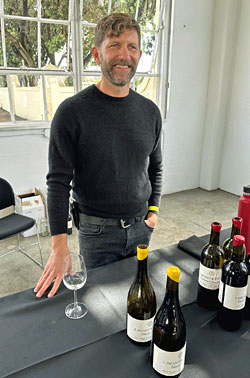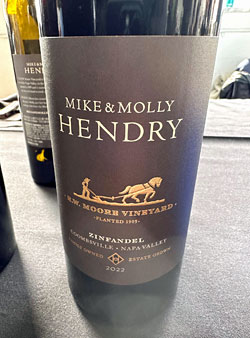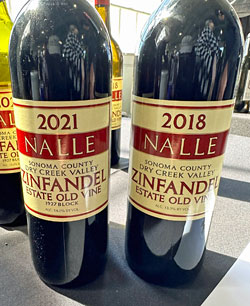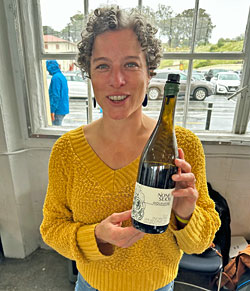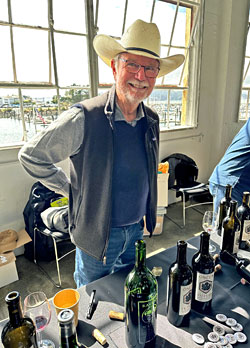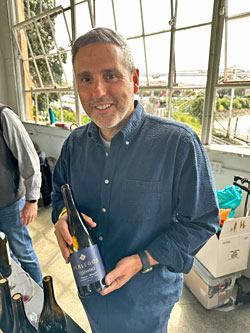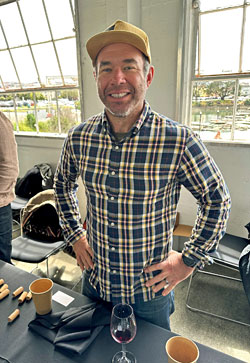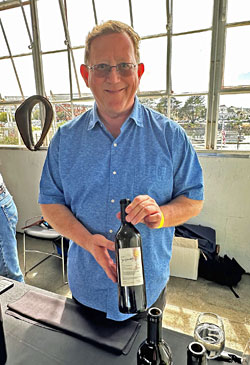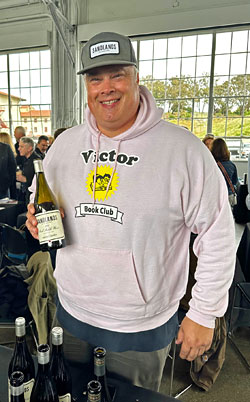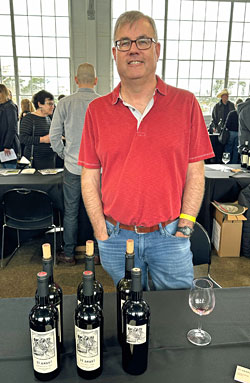Arnot-Roberts
The winery was founded by Duncan Arnot Meyers and Nathan Roberts in 2002. While they continue to make varieties such as Chardonnay, Pinot Noir, Cabernet Sauvignon, and Syrah, Arnot-Roberts has also become known in recent years for wines from lesser-known California grapes from older vineyards. My favorite at this table was the 2021 Old Vine White from Farmer Family Vineyard in Sonoma Valley, a field blend headed by about 85% Riesling. This featured bright citrus fruit with undertones of petrol and flowers, medium-light mouthfeel and a lively finish.
Bedrock
Bedrock’s Morgan Twain-Peterson is the son of Ravenswood winery founder and current Once & Future proprietor Joel Peterson, and he founded the label in 2007. Chris Cottrell joined Morgan as a partner in Bedrock in 2012. Morgan and Bedrock have brought much attention to the preservation of old and historic vineyards, and much of the fruit for their wines comes from old vines. Morgan poured three wines and all of them were enjoyable, with two particular highlights. The 2022 Nervo Ranch Heritage Wine is a field blend from 17 varieties, mostly Zinfandel and Négrette – this had brambly red and black berry fruit, a savory herbal component, and a firm tannic finish. The 2022 Bedrock Vineyard “Ode to Lucien” was a real standout. Made entirely from Mourvèdre with some whole-cluster fermentation, it was plummy and earthy with stony mineral and iron notes, and a lively texture and moderate tannins.
Birichino
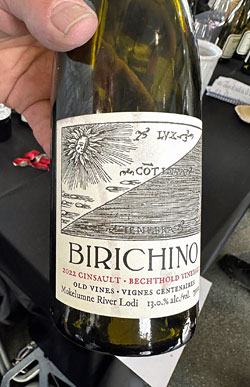 |
Proprietors Alex Krause and John Locke established Birichino in Santa Cruz in 2008. Although Pinot Noir is one of the varieties they work with, they’re better-known for their wines from varieties that were once more common in California than they are now – Chenin Blanc, old-vine Grenache and Mourvèdre, Cinsault, and Zinfandel among them. I got to the winery table at the very end of the tasting and only had time to try two wines, but they were both noteworthy. The 2022 Bechthold Vineyard Cinsault from Lodi featured bright red fruit plus spice and stony mineral notes, with medium body and fine tannins. Even better was the 2022 Enz Vineyard Mourvèdre from San Benito County, with plum and black cherry fruit, iron, and earth aromas, great structure, and a firmer tannic finish.
Carol Shelton
Carol launched her eponymous winery in 2000, after earning an enology degree from UC Davis and spending nearly 20 years as winemaker for Windsor Vineyards. She’s become particularly known for her Zinfandels, which she sources from up and down California. She poured her wines at the tasting and several were noteworthy. The 2019 “Wireless” Oat Valley Vineyard Carignane displayed earthy darker berry fruit plus spice notes, with a lively texture and moderate tannins. The 2021 “Monga” Lopez Vineyard Zinfandel from 100+ year-old vines in Cucamonga Valley was bright and brambly, with ripe berry fruit, spice, and firmer tannins on the finish. One more notable Zin was the 2021 “Collins Reserve” Collins-Limerick Lane Vineyard Zinfandel from Russian River Valley – with a bolder fruit profile than the “Monga”, this also had plenty of spice, hints of flowers, and a more structured mouthfeel and finish.
Corison Winery
Winemaker Cathy Corison and her husband William Martin established Corison Winery in 1987 in Napa Valley, and in 1995 they purchased their Kronos Vineyard property in the St. Helena AVA. They added a second estate vineyard, Sunbasket, in 2015. Corison has been famed for producing some of Napa Valley’s most balanced and elegant Cabernets. Cathy and her daughter Grace were on hand, and they poured only one wine, but it was one of my favorite wine of the entire tasting. The 2019 Kronos Vineyard Cabernet Sauvignon from the St. Helena AVA of Napa Valley featured currant and darker berry fruit with dried herb and stony mineral notes in support, hints of flowers and spice, a full-bodied mouthfeel yet with a lively texture, and firm but refined tannins on the finish. With perfect balance, everything worked together seamlessly – Napa Valley Cabernet doesn’t get any better than this.
Desire Lines Wine Co.
Winemaker Cody Rasmussen and his wife Emily founded Desire Lines in 2014. Cody is also the assistant winemaker at Bedrock, and works with vineyards all over northern California for the Desire Lines wines, focusing on old vine fruit. Cody was on hand at the tasting, and I liked all three wines that he poured, with two particular favorites. From a site in the mountains of Mendocino County that’s also the country’s smallest AVA, the 2022 Cole Ranch Riesling displayed citrus, stone fruit, and petrol aromas with floral undertones, medium weight with great texture. The 2022 Evangelho Vineyard Red Wine includes mostly Carignan, and had earthy plum and black cherry fruit with spice and dried herb undertones, good structure and firm but not aggressive tannins.
Enfield Wine Co.
John Lockwood and Amy Seese started Enfield in 2010 while John was working with Ehren Jordan at Failla, and it’s been a full-time project since 2013. He’d worked at Littorai and elsewhere prior to that. Enfield sources fruit from smaller growers from a number of California regions. John poured two wines at the event, and both were noteworthy. The 2018 Haynes Vineyard Old Vine Chardonnay from the cool Coombsville AVA of Napa was a standout, with bright stone fruit and pear aromas and floral undertones, fine texture and a vibrant finish. A barrel sample of 2023 Evangelho Vineyard Carignan had lots of spice, with dark berry fruit, earth, and a stony mineral note, with plenty of structure and a firm tannic finish.
Fine Disregard Wine Co.
Fine Disregard was founded in 2015 by Mike Schieffer and Kara Maraden. Mike is the assistant winemaker for Turley, while Kara is the director of viticulture for Foley Family Farms, and both have worked for other noted wineries in Napa Valley and elsewhere. Mike poured three wines at the tasting – I enjoyed all of them and had two favorites. The 2021 Chalone Vineyard Chenin Blanc was whole-cluster pressed and aged in neutral oak, and displayed bright pear and spice with earth and floral notes, medium body, and a lively finish. The 2020 Pato Vineyard Mataro from Contra Costa County had red fruit, flowers, earth, and iron aromas, a vibrant texture, and moderate tannins.
Graziano Family of Wines
Graziano Family of Wines includes four labels – Saint Gregory, Monte Volpe, Enotria, and Graziano. Vintner Greg Graziano has family roots in the Mendocino County wine business stretching back over a century, and his daughter is carrying on the family tradition. Greg poured several Graziano wines at the tasting and I particularly liked two of them, both from Mendocino County. The 2023 Chenin Blanc from Heil Vineyard in Ukiah Valley was fermented in neutral oak, and had great purity of fresh pear fruit along with floral notes, medium weight on the palate, and a long finish. The 2023 Carignane Rosé from Vincenzo Vineyard near Calpella in Mendocino County showed a subtle red-fruited character with floral undertones, and a lively mouthfeel and finish.
I. Brand & Family
I. Brand & Family Wines includes three labels – La Marea (focusing on Iberian varieties), Le P'tit Paysan (value-priced varietals and blends), and I. Brand and Family (higher-end single-vineyard wines), with fruit sourced from vineyards in the northern Central Coast region. Winemaker Ian Brand poured his wines at the tasting, and two from Massa Vineyard in Carmel Valley stood out. The 2022 Massa Vineyard Chenin Blanc featured pear, spice, and floral aromas with medium body and a pleasant finish. The 2021 Massa Vineyard Cabernet Sauvignon was herbal and a bit earthy, with currant and darker fruit, great structure, and fine tannins.
Mike & Molly Hendry
Both Mike and Molly Hendry have long roots in Napa Valley. Mike’s grandparents purchased property near the base of Mount Veeder, and this is now the Hendry Ranch Vineyard and Winery. Molly’s aunt and uncle, Denise and Bill (R.W.) Moore, had their own vineyard in the Coombsville region of Napa. Mike and Molly made their first Zinfandel from this century-old vineyard in 2009. I greatly enjoyed their 2022 R.W. Moore Vineyard Zinfandel, which was very aromatic, with floral and red fruit, hints of herbs and spice, with a lively texture and fine tannins.
Nalle Winery
The Nalle family has owned their vineyard property in Dry Creek Valley since 1927. The winery is run by Doug and Lee Nalle and their son Andrew, who now makes the wines. Doug and Lee started the label in 1984, and they are known as Zinfandel specialists, though there is also Carignane, Cabernet, and Merlot at their estate site and they purchase some fruit for other vineyards as well. My favorite of two vintages of their Zin wine at the table was the 2018 Estate Old Vine 1927 Block Zinfandel – this showed bright berry fruit, earth, with brambly and peppery notes and a refined mouthfeel and lively finish, one of the day’s more elegant Zins.
NoneSuch Wines
Caitlin Quinn is the assistant winemaker at Arnot-Roberts, and she launched own NoneSuch label in 2017. She’s worked for wineries in the Santa Cruz Mountains and in New Zealand as well. She works with a diverse group of vineyards and grape varieties. Caitlin poured one wine, and it was a standout. The 2019 Enz Vineyard Mourvèdre was fermented entirely with whole-cluster fermentation and aged in neutral oak. The wine was earthy, with bright black cherry and plum fruit, savory herbs, and a stony mineral note, with a great texture and moderate tannins.
|
Once & Future Wine
Once & Future is the new label of one of California’s legendary vintners, Joel Peterson. Joel founded the Ravenswood label in 1976 and ran it until he sold it in 2001. Once & Future, launched about ten years ago, represents Joel returning to his wine roots, making limited bottlings from small, old-vine fruit sources. Joel poured two of his new wines along with an older Ravenswood Zin at the event. My favorite of the two current wines was the 2021 Bedrock Vineyard Old Vine Zinfandel from Sonoma Valley, with bright and brambly red fruit, spice, and hints of pepper and earth, medium body, and a lively texture and finish. Also from Sonoma Valley, the Ravenswood 2006 Old Hill Ranch Zinfandel, poured from a magnum, featured nicely aged red fruit, spice, and herbs on the nose, and still had great structure and grippy tannins.
Perlegos Family Wine Co.
The parents of Jeff and John Perlegos farmed a California vineyard so it was only natural for them to follow the tradition. They purchased the historic Stampede Vineyard in the Clements Hills AVA of eastern Lodi. They sell fruit from there to a number of noted vintners and make some themselves. Jeff poured two vintages of the his old-vine Zin, and my favorite was the 2020 Stampede Vineyard Zinfandel – this was very aromatic, with floral and red fruit notes along with some earth and spice, medium-bodied with fine tannins.
Precedent Wines
Precedent is the project of Thomas Fogarty winemaker Nathan Kandler, who poured his wines at the tasting. He began the label in 2006, and over the years he has sought out special – and typically older – vineyards for his fruit sources. Nathan was on hand to pour his wines at the event. I enjoyed all of them and thought two were real standouts. The 2019 Wirz Vineyard Riesling from San Benito County spent 40 months in a large wood oval, and showed stone fruit and petrol aromas with undertones of citrus and flowers, with medium weight on the palate and a lively mouthfeel and finish. The 2022 Spenker Vineyard Carignan from Lodi had raspberry fruit, earth, and spice notes with great depth and moderate tannins.
Quivira Vineyards
Quivira has become one of the most notable producers of Rhône-style wines from Dry Creek Valley since winemaker Hugh Chappelle arrived in 2010. Hugh worked for several noted wineries including Flowers and Lynmar prior to Quivira. The estate vineyard, Wine Creek Ranch, is farmed biodynamically and Demeter-certified, and the winery also purchases fruit from other sites. Hugh poured a four-vintage vertical of Zinfandel from Katz Vineyard in Dry Creek Valley at the tasting – it’s a field blend that also includes a little Petite Sirah, Alicante Bouschet, Carignane, and other varieties – and I had two favorites. The 2020 Katz Vineyard Old Vine Zinfandel had bright and brambly red fruit with floral undertones, a lively mouthfeel, and fine tannins, a very elegant Zin. The 2019 Katz Vineyard Old Vine Zinfandel had more forward fruit along with spice and hints of earth and pepper, with a bit more structure and tannin.
Reichwage Winery
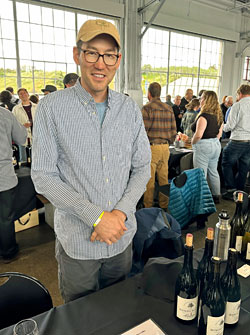 |
Reichwage was established in 2014 by winemaker Max Reichwage. He’d worked for wineries in Napa, Sonoma, Italy, Burgundy, and Tasmania. The winery focus is on Pinot Noir from their Sonoma Coast estate Twin Hills Vineyard and on the old-vine white and red varieties from their Russian River Valley estate Mancini Ranch. Max was on hand at the tasting, and I enjoyed all three wines he poured. The 2021 Mancini Ranch White Wine is a field blend of Palomino, Muscadelle, French Colombard, and a few other varieties – this was bright, with citrus, green apple, and floral aromas, fine acidity, and a refreshing finish. The 2019 Mancini Ranch Carignane, fermented entirely with whole clusters, was earthy and herbal, with black cherry fruit and undertones of spice and good structure. Max finished up with the 2020 Mancini Ranch Zinfandel, which displayed great purity of bright red fruit along with brambly, earthy, and peppery notes in support, with great texture and a firm tannic finish.
Ridge Vineyards
 |
Ridge is one of California’s most renowned wineries, founded in 1959. Paul Draper joined Ridge in 1969 and headed their winemaking team until his retirement in 2016. John Olney now heads up the winemaking team – Trester Goetting is the winemaker at Monte Bello while Shauna Rosenblum is the winemaker at the Lytton Springs facility. David Gates, who’s in charge of vineyard operations, poured the Ridge wines at the tasting. From Russian River Valley, the 2019 “Mancini Ranch” is 73% Carignane and 27% Zinfandel – this had bright raspberry and black cherry fruit with earth and spice undertones, a very lively texture, and moderate tannins. A pre-release wine, the 2022 “Pagani Ranch” Norma’s Block from Sonoma Valley is 78% Zinfandel with smaller percentages of Petite Sirah, Alicante Bouschet, Grand Noir, and Lenoir. Very fruit-forward, with floral notes and undertones of spice and black pepper, this had good structure and firm but refined tannins. The 2023 “Heritage Vines Blanc” is another pre-release wine and was sourced from both Mancini Ranch and Pagani Ranch – it’s mostly Palomino and Muscadelle with small amounts of Sémillon, Chenin Blanc, and Burger. With very bright pear and stone fruit aromas plus touches of flowers and earth, this was medium-bodied with a lively texture and finish.
Sandlands Vineyards
Sandlands is the label of Turley winemaker Tegan Passalacqua and his wife Olivia. The focus is on older grape varieties of California – such as Chenin Blanc, Carignane, Trousseau, and Mataro – and mostly sourced from old vines. Tegan searches out nearly-forgotten vineyards, particularly those with sandy decomposed granite soil. The first vintage for the Sandlands wines was in 2010. Tegan poured his wines at the tasting – all three were good with two particular favorites. The 2022 Contra Costa County Red Table Wine consists of 65% Carignane and 35% Mataro from Oakley Road Vineyard, and featured darker berry fruit, earth, spice, and a minerally iron note, with medium body, lively texture, and moderate tannins. The 2018 Napa Valley Chardonnay from Haynes Vineyard in Napa’s Coombsville AVA had bright citrus and apple fruit with touches of flowers and spice, and a very lively mouthfeel and finish.
Scar of the Sea
Scar of the Sea is the label of Mikey & Gina Giugni, who make their wines in San Luis Obispo. They work with vineyards in the cool-climate regions of coastal San Luis Obispo County and Santa Maria Valley, as well as with old vines in other regions such as Cucamonga Valley. Mikey poured his wines at the event and one in particular stood out to me. The 2023 Lopez Vineyard Palomino from Cucamonga Valley spent eight days on the skins prior to pressing, and featured lots of spice and orangepeel aromas along with stone fruit, a medium texture, and a lively finish.
Scythian Wine Co.
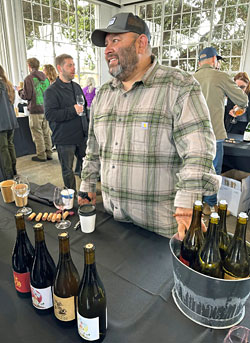 |
Established in 2021, Scythian is a newer project of vintner Raj Parr. Scythian works with old and nearly forgotten vineyards in Los Angeles and Riverside counties, once a major California wine region. The own-rooted, dry-farmed vines in this area that Raj works with have been disappearing over the years and he is dedicated to helping to preserve them. Raj was on hand to pour his wines at the tasting, and I thought two of them in particular stood out, both from Lopez Vineyard in Cucamonga Valley. The 2021 “The Scythians” Palomino was fermented with some skin contact, then aged for a year in a cask where flor yeast was allowed to grow, and then aged a further year in bottle. This wine was quite distinctive, with sherry-like aromas along with apple and spice notes, medium body and a bit of tannin on the finish. The 2023 “Revolution” Red is 60% Zinfandel, 30% Palomino, and 10% Grenache, and displayed ripe berry fruit, spice, plus herbal and earth notes, with medium-light body and a pleasant finish.
St. Amant
St. Amant was established in 1981 by the Spencer family, and winemaker Stuart Spencer and his mother Barbara are the proprietors. St. Amant works with Iberian grape varieties from the family’s Amador County vineyard as well as old-vine Zinfandel and other varieties from Lodi. Stuart was on hand to pour his wines (with newly-updated label designs) at the event, and I thought two of them were standouts. The 2022 Marian’s Vineyard Zinfandel is sourced from 120+ year old vines, and the wine displayed brambly ripe red fruit, spice, a stony mineral note, and a touch of oak, with medium weight and moderate tannins. A new bottling for St. Amant, the 2022 Mohr-Fry Ranches “Heritage Red” includes mostly Zinfandel plus other varieties. This was more earthy, with a darker fruit profile than the Zin, with savory herbal undertones, a more structured mouthfeel, and firmer tannins – tasty now but worth cellaring for further development.
Stirm Wine Co.
Ryan Stirm launched his wine label with the 2013 vintage. The winery has been especially known for Riesling, and Ryan also works with several grape varieties such as Cabernet Pfeffer from old vineyards in San Benito County. Ryan poured his wines at the tasting – they were all good, with a couple of particular favorites. The 2017 Wirz Vineyard Riesling featured plenty of characteristic petrol aromas along with stone fruit and a hint of flowers, with a great texture and lively finish. The 2020 Wirz Vineyard Cabernet Pfeffer had plum and black cherry fruit, spice, dried herbs, and touches of pepper and stony minerals, with medium body and a firm tannic finish.
Turley Wine Cellars
Larry Turley established his eponymous label in 1993. The winery has specialized in single-vineyard old-vine Zinfandel, though they produce other varieties as well. Fruit is sourced from over 30 vineyard sites, stretching from Paso Robles to Amador County as well as Napa and Sonoma. Longtime assistant Tegan Passalacqua became Turley’s head winemaker and vineyard manager in 2013, and he poured one Turley wine at the event. The 2023 Bechthold Vineyard Cinsault had bright and savory herbal red fruit with stony mineral undertones, medium body, and refined tannins.
Under The Wire
For their Under The Wire label, Chris Cottrell and Morgan Twain-Peterson of Bedrock Wine Co. make sparking wines using the traditional Méthode Champenoise. They source fruit from a number of vineyards stretching from Mendocino to Monterey counties. Chris was on hand to pour the Under The Wire wine at the tasting. There was just one wine at this table but it was a good one – the 2018 Bedrock Vineyard Sparkling Zinfandel displayed bright yet subtle red fruit with some floral and yeasty notes in support, and fine bubbles. |


